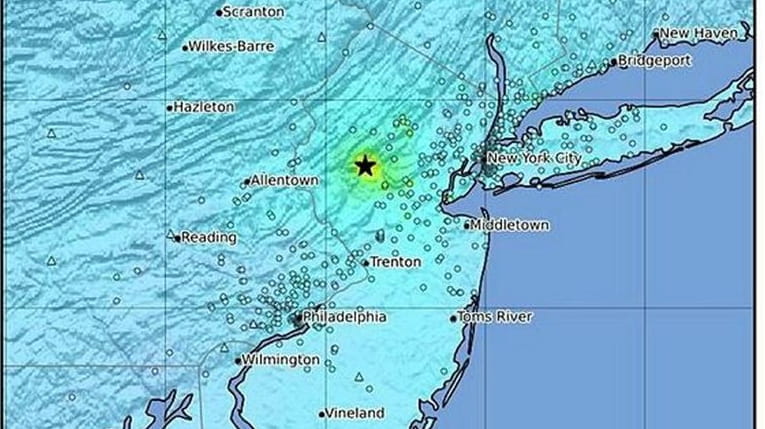Magnitude 2.6 aftershock reported on Long Island following Friday earthquake

A U.S. Geological Survey map shows the epicenter of Friday's 4.8 magnitude earthquake felt on Long Island and the Northeast. Credit: U.S. Geological Survey
Seismologists on Wednesday recorded the latest of nearly four dozen aftershocks from last week's earthquake that shook Long Island and much of the Northeast, but experts said post-temblor seismic activity is normal and, in the latest example, “dying off” fast.
The magnitude 2.6 quake struck Wednesday at about 10:22 a.m. beneath Gladstone, New Jersey. It was one of 47 aftershocks since Friday’s magnitude 4.8 quake, which had an epicenter about 10 miles away in Whitehouse Station.
The aftershock was measured at about three miles deep and had a general radius of more than 60 miles. Both Nassau and Suffolk county police said they received no reports about the temblor. It had about half the magnitude of Friday’s quake, estimated by the U.S. Geological Survey to have been the strongest recorded in New Jersey in 250 years. Friday's earthquake did not result in any major damage or injuries, officials said.
Light shaking within 25 miles of the epicenter was reported after Wednesday's aftershock on Long Island, including in Hicksville and along parts of the North Shore, as well as in New York City, said William Holt, a professor of geophysics at Stony Brook University.
“It may have been felt only by a few people at rest, especially in high buildings. There’s nothing to indicate it was widely felt,” Holt said. “It’s surprising anyone felt it on Long Island. It looks like a normal sequence of aftershocks. They’ve been mostly very small and not detected by people.”
Additional aftershocks are likely for the next several weeks, according to experts. Most of the smaller quakes so far have measured at magnitudes of 2.2 or less, which generally are not noticeable. The strongest aftershock — 3.7 Friday night — was also centered in Gladstone, the USGS said.
“The 4.8 quake was big enough that it’s going to have aftershock frequency and it’s hard to say exactly how long it’s going to last,” said USGS seismologist Susan Hough. “The number of aftershocks decays with time. This one is decaying faster, with the number of aftershocks dying off more quickly.”
There is less than a 1% chance of another earthquake in the region larger than Friday's temblor, according to the USGS. There is a 1 in 200 chance of a quake in the region reaching 5.0 or higher in the next year according to the USGS.
There is about a 5% chance of an earthquake of 4.0 or higher within the next year and a 34% chance of another earthquake or aftershock at magnitude 3.0 or higher, according to the USGS.
Two body parts suspects in court ... Teen chicken keeper ... Rangers advance ... Penn upgrades
Two body parts suspects in court ... Teen chicken keeper ... Rangers advance ... Penn upgrades

